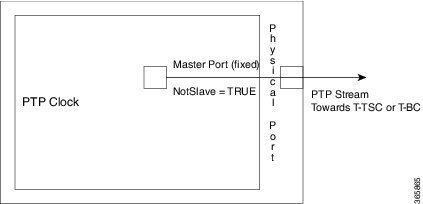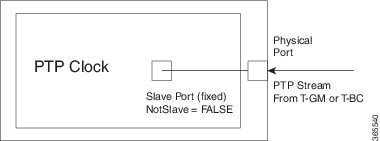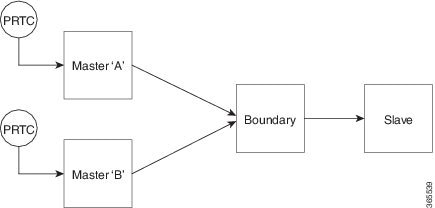Why G.8275.1?
The G.8275.1 profile is used in mobile cellular systems that require accurate synchronization of time and phase. For example, the fourth generation (4G) of mobile telecommunications technology.
The G.8275.1 profile is also used in telecom networks where phase or time-of-day synchronization is required and where each network device participates in the PTP protocol.
Because a boundary clock is used at every node in the chain between PTP Grandmaster and PTP Subordinate, there is reduction in time error accumulation through the network.
More About G.8275.1
The G.8275.1 must meet the following requirements:
-
Non-participant devices, that is, devices that only forward PTP packets, and PTP transparent clocks are not allowed.
-
The telecom grandmaster (T-GM) provides timing to all other devices on the network. It does not synchronize its local clock with any other network element other than the Primary Reference Time Clock (PRTC). T-GM in locked mode must have phase and frequency sources that are traceable to PRTC. T-GM in locked mode must always have QL-PRC/PRS frequency. T-GM can be in holdover when losing phase. In such case, its default clock class is defined based on the available frequency source quality.
-
The telecom time subordinate clock (T-TSC) synchronizes its local clock to another PTP clock (in most cases, the T-BC), and does not provide synchronization through PTP to any other device.
-
The telecom boundary clock (T-BC) synchronizes its local clock to a T-GM or an upstream T-BC, and provides timing information to downstream T-BCs or T-TSCs. If at a given point in time there are no higher-quality clocks available to a T-BC to synchronize to, it may act as a grandmaster.
The following figure describes a sample G.8275.1 topology.

PTP Domain
A PTP domain is a logical grouping of clocks that communicate with each other using the PTP protocol.
A single computer network can have multiple PTP domains operating separately, for example, one set of clocks synchronized to one time scale and another set of clocks synchronized to another time scale. PTP can run over either Ethernet or IP, so a domain can correspond to a local area network or it can extend across a wide area network.
The allowed domain numbers of PTP domains within a G.8275.1 network are between 24 and 43 (both inclusive).
PTP Messages and Transport
The following PTP transport parameters are defined:
- For transmitting PTP packets, either the forwardable multicast MAC address (01-1B-19-00-00-00) or the non-forwardable multicast MAC address (01-80-C2-00-00-0E) must be used as the destination MAC address. The MAC address in use is selected on a per-port basis through the configuration. However, the non-forwardable multicast MAC address (01-80-C2-00-00-0E) will be used if no destination MAC is configured.
The source MAC address is the interface MAC address.
- For receiving PTP packets, both multicast MAC addresses (01-80-C2-00-00-0E and 01-1B-19-00-00-00) are supported.
- The packet rate for Announce messages is 8 packets-per-second. For Sync, Delay-Req, and Delay-Resp messages, the rate is 16 packets-per-second.
- Signaling and management messages are not used.
PTP Modes
Two-Way Operation
To transport phase and time synchronization and to measure propagation delay, PTP operation must be two-way in this profile. Therefore, only two-way operation is allowed in this profile.
PTP Clocks
Two types of ordinary clocks and boundary clocks are used in this profile:
Ordinary Clock (OC)
- OC that can only be a grandmaster clock (T-GM). In this case, one port will be used as master port.
The T-GM uses the frequency, 1PPS, and ToD input from an upstream grandmaster clock.
 Note |
The T-GM master port is a fixed master port. |

- OC that can only be a slave clock (T-TSC). In this case, only one PTP port is used for T-TSC, which in turn will have only one PTP master associated with it.

Boundary Clock (T-BC)
- T-GM in boundary clock is not supported.
- T-BC that can become a master clock and can also be a slave clock to another PTP clock.
If the BMCA selects a port on the T-BC to be a slave port, all other ports are moved into the master role or a passive state.

PTP Ports
A port can be configured to perform either fixed master or slave role or can be configured to change its role dynamically. If no role is assigned to a port, it can dynamically assume a master, passive, or slave role based on the BMCA.
A master port provides the clock to its downstream peers.
A slave port receives clock from an upstream peer.
A dynamic port can work either as a master or a slave based on the BMCA decision.
In Cisco’s implementation of the G.8275.1:
- OC clocks can support only fixed master or slave port.
- One PTP port can communicate with only one PTP peer.
- The maximum number of clock-ports on a T-BC is limited to the number of 1GE and 10GE interfaces.
Alternate BMCA
The BMCA implementation in G.8275.1 is different from that in the default PTP profile. The G.8275.1 implementation is called the Alternate BMCA. Each device uses the alternate BMCA to select a clock to synchronize to, and to decide the port states of its local ports.
Benefits
With upcoming technologies like LTE-TDD, LTE-A CoMP, LTE-MBSFN and Location-based services, eNodeBs (base station devices) are required to be accurately synchronized in phase and time. Having GNSS systems at each node is not only expensive, but also introduces vulnerabilities. The G.8275.1 profile meets the synchronization requirements of these new technologies.
Prerequisites for Using the G.8275.1 Profile
- PTP over Multicast Ethernet must be used.
- Cisco ASR 901 Router must be enabled using network-clock synchronization mode QL-enabled command on T-GM and T-BC.
- Every node in the network must be PTP aware.
- It is mandatory to have a stable physical layer frequency whilst using PTP to define the phase.
- Multiple active grandmasters are recommended for redundancy.
Restrictions for Using the G.8275.1 Profile
- PTP Transparent clocks are not permitted in this profile.
- Changing PTP profile under an existing clock configuration is not allowed. Different ports under the same clock cannot have different profiles. You must remove clock configuration before changing the PTP profile. Only removing all the ports under a clock is not sufficient.
- One PTP port is associated with only one physical port in this profile.
- There is no support for BDI and VLAN.
- Signaling and management messages are not used.
- PTP message rates are not configurable.
- Non-hybrid T-TSC and T-BC clock configurations are not supported.
- SyncE is not compliant with G.8262 when G.8275.1 is enabled.
- Virtual Port is not supported.

 Feedback
Feedback